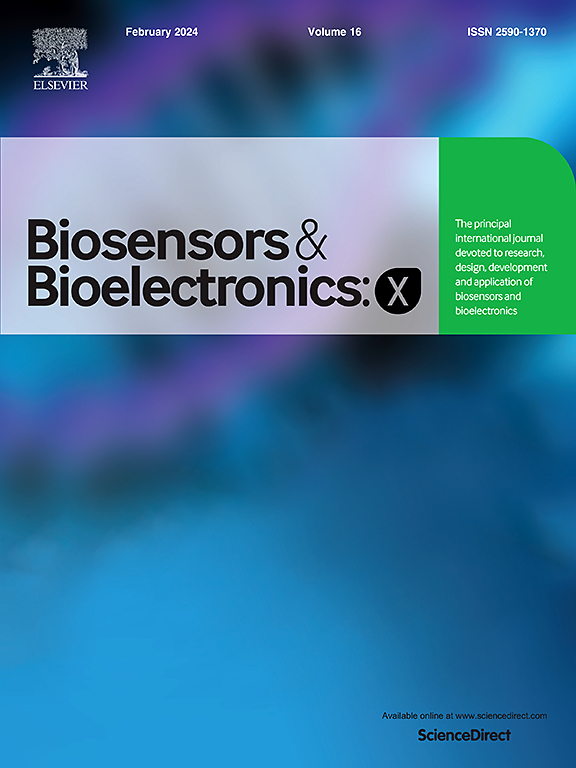Personal glucose meter-based portable method for creatine kinase assay
IF 10.61
Q3 Biochemistry, Genetics and Molecular Biology
引用次数: 0
Abstract
We herein developed a simple and label-free method to detect the creatine kinase (CK) activity by employing a personal glucose meter (PGM) as a detection device. This method relies on the target-induced consumption of glucose by the cascade enzymatic reaction (CER) promoted by the combined activities of CK and hexokinase (HK). The target CK first catalyzes the phosphorylation of adenosine 5′-diphosphate (ADP) to adenosine 5′-triphosphate (ATP) using creatine phosphate (CP) as a phosphate donor. HK then phosphorylates glucose into glucose-6-phosphate by converting the produced ATP back to ADP, which could enter another cycle of the CER to further phosphorylate glucose in a sample. As a consequence, the glucose level would decrease depending on the CK activity, which could be very conveniently detected using a PGM. With this unique design principle, we successfully determined the CK activity down to 0.0147 U/mL with high specificity against various non-target enzymes. We also verified that the developed strategy can reliably detect CK activity in heterogeneous human blood, ensuring its robust utility in various clinical applications. This user-friendly method enables point-of care detection of CK, offering a practical tool for monitoring muscle health. By allowing simultaneous tracking of CK and glucose levels with the same PGM device, this approach is particularly beneficial for diabetes mellitus (DM) patients, empowering them to proactively manage their health and reduce the risk of muscle-related complications.
基于个人血糖仪的便携式肌酸激酶测定方法
我们在此开发了一种简单且无标记的方法,通过使用个人血糖仪(PGM)作为检测装置来检测肌酸激酶(CK)的活性。该方法依赖于CK和己糖激酶(HK)联合活性促进的级联酶反应(CER)对葡萄糖的靶向诱导消耗。靶细胞CK首先以磷酸肌酸(CP)作为磷酸供体,催化5′-二磷酸腺苷(ADP)磷酸化为5′-三磷酸腺苷(ATP)。然后HK通过将产生的ATP转化回ADP,将葡萄糖磷酸化为葡萄糖-6-磷酸,ADP可以进入CER的另一个循环,进一步磷酸化样品中的葡萄糖。因此,葡萄糖水平会根据CK活性而降低,这可以非常方便地使用PGM检测。利用这一独特的设计原理,我们成功地测定了CK活性低至0.0147 U/mL,对各种非靶酶具有高特异性。我们还验证了开发的策略可以可靠地检测异种人类血液中的CK活性,确保其在各种临床应用中的强大实用性。这种用户友好的方法,使点护理检测CK,提供了一个实用的工具,监测肌肉健康。通过使用相同的PGM设备同时跟踪CK和葡萄糖水平,这种方法对糖尿病(DM)患者特别有益,使他们能够主动管理自己的健康并降低肌肉相关并发症的风险。
本文章由计算机程序翻译,如有差异,请以英文原文为准。
求助全文
约1分钟内获得全文
求助全文
来源期刊

Biosensors and Bioelectronics: X
Biochemistry, Genetics and Molecular Biology-Biophysics
CiteScore
4.60
自引率
0.00%
发文量
166
审稿时长
54 days
期刊介绍:
Biosensors and Bioelectronics: X, an open-access companion journal of Biosensors and Bioelectronics, boasts a 2020 Impact Factor of 10.61 (Journal Citation Reports, Clarivate Analytics 2021). Offering authors the opportunity to share their innovative work freely and globally, Biosensors and Bioelectronics: X aims to be a timely and permanent source of information. The journal publishes original research papers, review articles, communications, editorial highlights, perspectives, opinions, and commentaries at the intersection of technological advancements and high-impact applications. Manuscripts submitted to Biosensors and Bioelectronics: X are assessed based on originality and innovation in technology development or applications, aligning with the journal's goal to cater to a broad audience interested in this dynamic field.
 求助内容:
求助内容: 应助结果提醒方式:
应助结果提醒方式:


